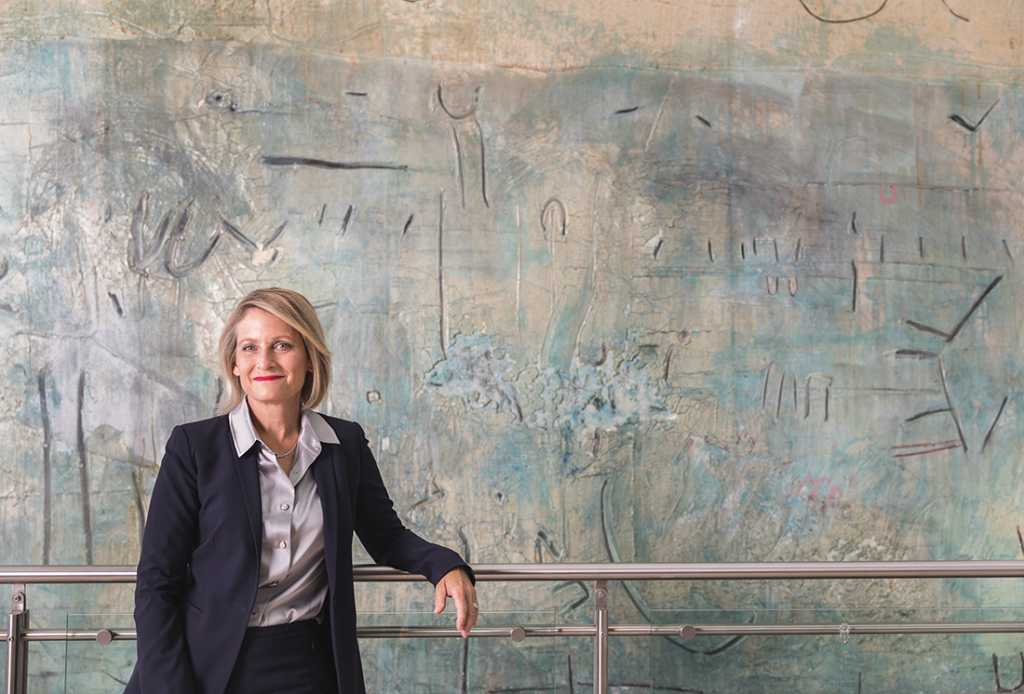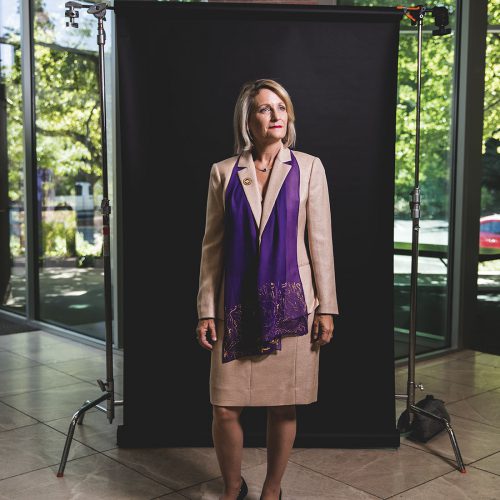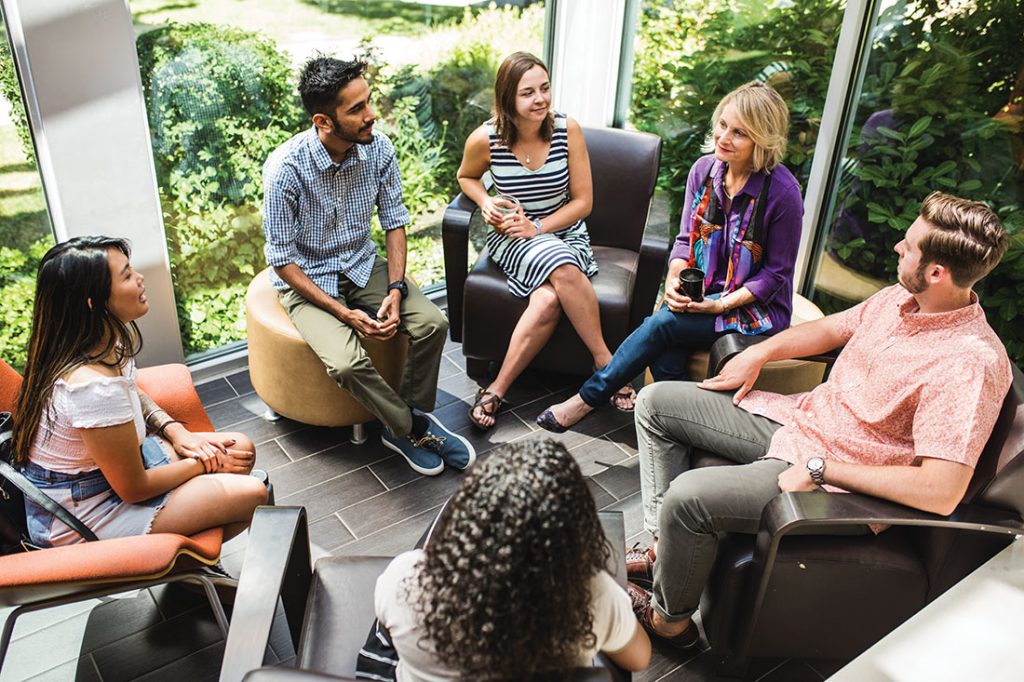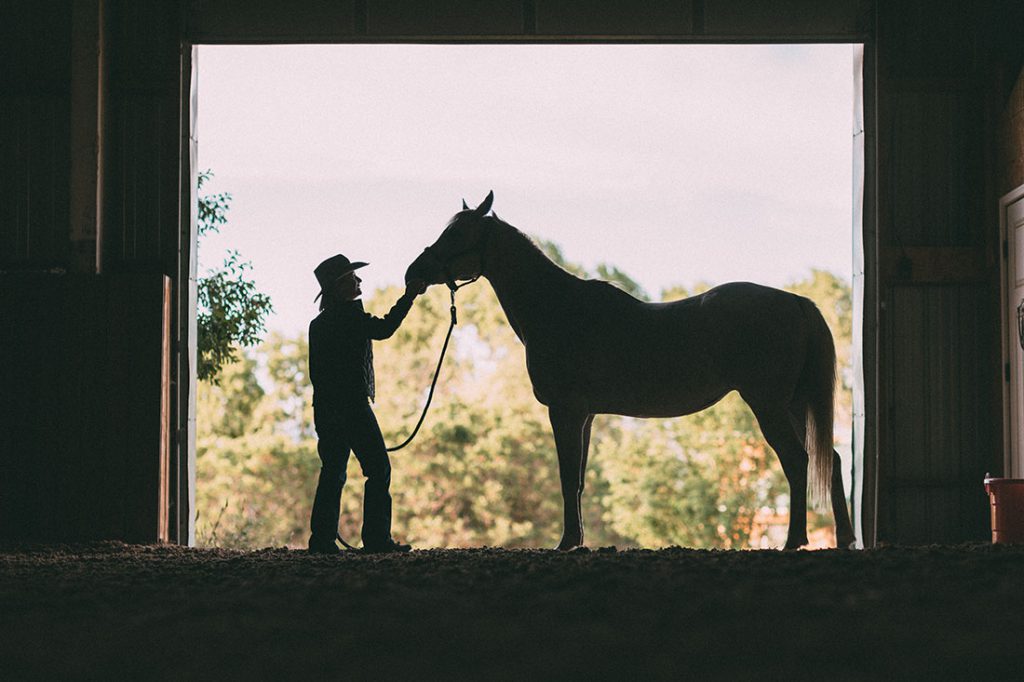
Westminster's 19th President

by Autumn Thatcher (MSC ’15)
Photography by Michael Kunde
On an unusually warm afternoon for the month of May, I sat in a booth at the Vault, located inside Hotel Monaco in Salt Lake City, awaiting the arrival of Dr. Bethami Dobkin. I triple-checked my recorder to make sure that it was working, reread my interview questions, and sipped on some water. I was nervous. Dr. Dobkin walked into the little bar in a breeze of confidence. She sat down, offered a let’s-get-to-business smile, and ordered a coffee. As the writer responsible for introducing the alumni community to Westminster’s 19th president, I felt a lot of pressure to get to the bottom of just who Dr. Dobkin is. I was prepared to ask questions that would help me weave together the pieces of her life and present a narrative that captures her personal journey. Not too long into the interview, however, talking with Beth Dobkin had me rethinking my intentions. Nonetheless, background information is crucial to any story, and this is how Beth’s begins.
Beth Dobkin grew up in Arcata, California. She attended Humboldt State University, where she earned a bachelor of arts degree with a major in speech communication. She went on to earn an MA in communication/rhetoric and a PhD in communication/rhetoric and social order from the University of Massachusetts. Beth is a nationally recognized author of several works about terrorism and foreign policy, news media, and speech communication, as well as a textbook she co-authored with Roger Pace called Communication in a Changing World (2003, 2006)—of which she says she is most proud. She became a tenured faculty member and full professor at the University of San Diego, where she taught for 17 years, and served as provost and academic vice president for Saint Mary’s College of California. She is no stranger to the liberal arts, earning a remarkable reputation in and out of the classroom and winning awards for her achievements as she worked her way up the administrative ranks in higher education. Throughout her storied career, Beth remained at the head of the classroom, even while serving in her role as provost. At her core, Beth Dobkin is an educator—and I was eager to learn.
My intent for this profile was to focus on Beth’s life story and discover what experiences have helped shape who she is. I wanted to know more about her love for horses and the way in which she met her spouse and number-one fan, Randy Chiotti, and to find out how she navigated managing a successful career while simultaneously raising two children.
“You’re in a tough spot,” she says thoughtfully. “Because there’s this blend between getting to know the new president as a person and also honoring the work on the academic side. It’s a fine line to walk when talking about women, because we tend to personalize them and, to some extent, downplay the professional.”

Beth goes on to describe her passion for teaching and the ways education brings individuals together. Diversity—the range of human experience and perspective—she says, makes the world a richer place. She speaks to her experience being one of a few women working alongside many men. She has many fascinating things to say, but I am stuck spinning on whether or not my seemingly innocent intention to shape Beth for our readers was in fact diminishing her incredible professional success. I circle back to this because I can’t let it go. In this moment, I have stepped into the classroom experience with Beth Dobkin. Her expertise in gender studies and communication has me hanging on her every word, and I forget that I am supposed to be taking notes.
“I tend to shy away from generalizations about what it means to be a woman,” Beth explains in regard to joining four other female presidents in higher education in the state of Utah. That in itself is worth noting, but Beth is careful to remind me that the fact that these leaders are all women should not distract us from the work that they have done to get to where they are. In other words, it is not only their gender identity that should be of interest to the general public. “We come to these positions with so many different identities that you don’t always know what part of you other people see. It can be subtle and different than how you see yourself. Being a woman might be important, or having a particular faith tradition, or your race, or your age all might influence who you are in complex ways.”
Beth tells me that her passion for education extends back to the Los Angeles area, where her parents, both children of immigrants, broke barriers to achieve success. Her maternal grandparents had limited access to education. Her grandfather, a Polish immigrant, taught himself to be a lawyer and opened many small businesses. Her grandmother helped him in his endeavors, which meant that they were away from home more often than not. Beth’s mother was looked after for quite some time by a Japanese caregiver who was interned during World War II, despite the futile attempts of her grandparents to intervene.
Beth’s father was the son of a Ukrainian immigrant who worked as a tailor. He graduated from a naval preflight academy during WWII, but upon trying to enlist, he was told that he was not eligible to serve because of his father’s origin. In response, he wrote to President Roosevelt demanding that he be allowed the opportunity to serve his country and fight for the freedom of its citizens. He eventually enlisted and served in the Navy during WWII and, because of the GI Bill®, became the first on both sides of her family to begin a college education. Beth’s parents both began their careers as educators in southern California, but during Beth’s early childhood they moved to Arcata, where Beth discovered that a great amount of diversity exists in even the smallest and most rural of places.

“Arcata was a college town, but also home to lumber and fishing industries—and to some extent (this was the ’70s) an underground economy and drug culture,” Beth says. “Navigating all of that while growing up meant that you saw the divisiveness in the community. For me, that’s probably when I became interested in seeing where common ground could happen between people and first recognized the importance of diplomacy while holding onto your values.”
Growing up, Beth aspired to be a writer for National Geographic. She worked hard in school and was equally ambitious in the stables at local barns, where she mucked her way into riding lessons, straddling her educational career with advancing in equestrian sports. “Growing up a young woman and having the responsibility of cleaning, feeding, and caring for something that is depending on you; earning the trust of a large, scary animal; and having a reason to want to work at 12 to pay for it all—that was really formative,” Beth says.
Beth didn’t graduate from high school, exactly. “I took the GED at 16,” she says. “At that time, there were no AP courses. There were no electives. I knew I wanted to go to college, so I took the courses that were required for admission. I wasn’t interested in taking courses just to fill a schedule, so I left.”
During college at Humboldt State University, Beth worked in her first administrative role: leading a riding program at a residential summer camp, where she managed 100 students, six staff members, and a herd of 30 horses. She took courses as a journalism and natural resource management major, where she worked toward landing that writing job with National Geographic. But a stint on the debate team proved to be a life-changing distraction.
“I started becoming interested in the possibilities and the limits of communication,” Beth says. “Communication was about a way of looking at how decisions were made and if they were fair.” While working on her doctorate, Beth’s research included an internship at Australian National University in Canberra, where she studied barrister examination strategies. Her plan was to attend law school, but the more she studied, the less sense a career in law made for her. Throughout her education, Beth explored many possibilities: she financed her education by working in high-end jewelry sales and was asked to be a diamond appraiser. She took the Foreign Service Exam with the intent to be a foreign diplomat, but she always came back to teaching.
“I thought that I could contribute more by being an educator and a researcher in issues of social conflict and decision making. It seemed like I could do the most good,” Beth says. “I used to tell my students to expand their behavioral repertoire—meaning, see the possibilities of the world. Think about how to make your actions congruent with your values. Figure out where your talents and passions are, and know how to be flexible and creative enough to make the most of those opportunities—not just for yourself, but for other people, too.”
Beth’s opportunities in administration came through mentors who identified her as someone with the potential to do great things in higher education. She has received many accolades throughout her career, including being listed as “Most Influential Woman in Business” two years in a row, by San Francisco Business Times; a “2013 Woman to Watch,” by Diablo Magazine; a “University Professor” for 2001–02 at University of San Diego; a National Communication Association Teaching Award recipient; a Faculty Fellow from the U.S. Institute of Peace in Washington, D.C.; and the list goes on. She has also given many presentations on a national level and has served as a board member for The Foundation for Hispanic Education, for Ujima Family Recovery Services, and for the American Council on Education Council of Fellows, and as commissioner for Western Association of Schools and Colleges (senior division). Suffice it to say, Beth stays involved. Her passion for education extends beyond her role as an educator and administrator within higher education and to her personal pursuit of continuous evolution, a characteristic that makes her the right person to lead Westminster.
“Your identity changes as you age,” Beth says. “Education helps you figure out how to understand both yourself and the world around you, and to clarify your values and commitments. Your goals may change, and you may belong to different communities. How do you develop the habits of mind, the qualities of character, and the skills to anchor you? For me, Westminster was appealing because the college’s mission and values support this kind of journey. The location is beautiful, and the size is ideal for creating a close academic community. Perhaps most compelling, though, was what the people of Westminster said they wanted in their next president. The presidential profile and interview process led me to believe that Westminster wanted a leader who appreciates everything that the college is and has been doing, who understands the power of community, and who believes in the importance of diversity and the practice of inclusion to achieve excellence.”
Throughout her career, Beth has applied a passion for diversity, equity, and inclusion in education to each role that she has occupied, whether in the classroom or at the administrative level. She used the question, “What difference does difference make?” to drive her classroom discussions, and she uses it still as a leader in higher education.
“For me, it’s been a path that started in 1992 in San Diego,” Beth says. “I was at a campus that was pretty homogenous and affluent and that was struggling to figure out how to serve a more diverse student population. To create a more diverse campus, you have to not just focus on demographics, but on the policies, practices, and culture that value what the diversity brings. You have to begin with empathy. That’s the first step in getting to inclusion.”

Beth is confident in the competency, skills, and experience she has to lead as Westminster’s 19th president. The many dimensions of who she is—an educator, a mother, a wife, an equestrian, a leader—all tie into one another and prepare her for this shift in her identity. “I see everything I do as connected. Even when I’m riding, it’s connected to the life of the mind, either in the moment of connection with the horse or in the moments of reflection afforded by nature,” Beth says. “That’s one of the things that attracts me to Westminster: it’s the liberal arts coming alive, the integration of physical environment and activity with the mind and heart.”
After two hours of conversation, I realize that I need to close my interview with Beth. But I don’t want to. I still have so many questions, but they have gone beyond what I should ask for the purpose of introducing the new president to the campus community and into bigger-picture questions that I realize can only be answered in time. Luckily, this is only the first of many opportunities to learn from Beth. “I am an all-in person,” Beth says. “I don’t move around. I invest in the place where I am because I invest in the people.”
As she meets with faculty and campus stakeholders, Beth looks toward moving Westminster to the forefront of equity within education, beginning with an emphasis on the fundamental importance of human relationships. As an educator, it only makes sense that her focus is on the students; and at Westminster, she knows that the campus community, similar to her, is all in. “The students are very important to me. Give students opportunity and support, and see what they can do,” she says. “There is an understanding that we need each other. If Westminster can be the kind of place that brings together diverse people and perspectives to create a collaborative learning community, then it becomes a model for solving some of the world’s toughest problems.”
About the Westminster Review
The Westminster Review is Westminster University’s bi-annual alumni magazine that is distributed to alumni and community members. Each issue aims to keep alumni updated on campus current events and highlights the accomplishments of current students, professors, and Westminster alum.
GET THE REVIEW IN PRINT STAY IN TOUCH SUBMIT YOUR STORY IDEA READ MORE WESTMINSTER STORIES